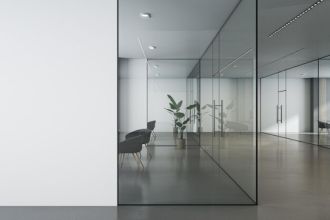Designing for Connection: The Impact of Glass Partition Walls in Offices
Office design is evolving, and the use of glass partition walls is at the forefront of this revolution. As businesses aim to encourage collaboration and connection among employees, the traditional walls that once separated teams are coming down. In their place, companies are opting for glass partition walls, a design choice that is as practical as it is aesthetically pleasing.
Connection-Centric Design: How Glass Partition Walls Foster a Sense of Unity in Office Spaces
The concept of connection-centric design is rooted in the belief that the physical environment of an office can significantly impact the way teams interact and work together. Glass partition walls, a key element in this design philosophy, aim to foster a sense of unity and openness in office spaces.
A defining feature of glass partition walls is their transparency. This design element removes the barriers that traditional opaque walls create, allowing for a free flow of light and sightlines across the office. The result is a space where employees can see and interact with one another easily, promoting a sense of unity and connection.
Moreover, glass partition walls can be a powerful visual symbol of a company's commitment to transparency and open communication. By replacing opaque walls with clear, glass partitions, businesses send a strong message that they value openness and inclusivity. This can help to foster a culture of trust and collaboration, further strengthening the sense of unity in the workplace.
Team Building Environments: The Impact of Glass Partition Walls on Interpersonal Connections
Another key benefit of glass partition walls lies in their potential to foster interpersonal connections. In traditional office layouts, employees are often isolated in individual offices or cubicles, limiting their opportunities for interaction. With glass partitions, however, this is not the case.
Glass partition walls create what is often referred to as a 'team building environment'. By allowing employees to see their colleagues at work, these partitions encourage regular communication and interaction. This can lead to stronger interpersonal connections, as employees get to know one another on a deeper level.
Furthermore, the use of glass partition walls can also foster a sense of shared responsibility and accountability. When employees can see their colleagues at work, they are more likely to feel a sense of collective ownership over projects and tasks. This sense of shared responsibility can, in turn, lead to increased teamwork and collaboration.
Designing for Engagement: Encouraging Connection through Thoughtful Placement of Glass Partition Walls
While the transparency of glass partition walls can foster connection and unity, it is essential to consider their placement carefully. Thoughtful placement of these walls can further enhance their potential to encourage engagement and connection among employees.
For instance, placing glass partition walls around meeting rooms and shared spaces can encourage participation and inclusivity. When employees can see their colleagues collaborating and brainstorming, they are more likely to feel a part of the process and contribute their ideas and insights.
Moreover, the strategic placement of glass partition walls can also help to minimize distractions. While the transparency of these walls can be beneficial, it can also potentially lead to visual distractions. By carefully considering the placement of these walls, businesses can ensure that employees can focus on their work while still benefiting from the sense of connection and engagement that these partitions foster.
Employee Well-Being: The Role of Glass Partition Walls in Creating Positive and Connected Office Environments
In addition to fostering connection and collaboration, glass partition walls also play a crucial role in promoting employee well-being. A well-lit, open, and connected office environment can significantly contribute to the overall health and happiness of employees.
One of the key benefits of glass partition walls is the natural light they allow to permeate the office. Studies have shown that exposure to natural light can improve mood, reduce stress, and enhance productivity and focus. As such, the use of glass partition walls can contribute to a more positive and healthy work environment.
Furthermore, the sense of connection and inclusivity that glass partition walls foster can also contribute to employee well-being. Feeling a part of a team and having regular interactions with colleagues can reduce feelings of isolation and loneliness, which are often associated with traditional office layouts.
In conclusion, the use of glass partition walls in office design can have a significant impact on promoting connection, collaboration, and well-being among employees. Through their transparency and flexibility, these partitions foster a sense of unity, encourage engagement, and contribute to a positive and healthy work environment. In an era where employee well-being and connection are increasingly valued, glass partition walls are not just a design trend, but a reflection of a broader shift towards more inclusive and human-centric workplaces.

